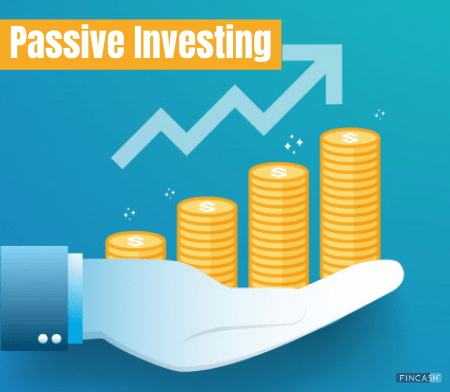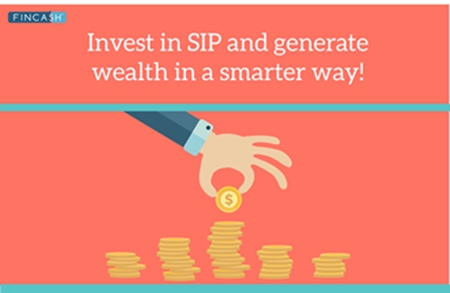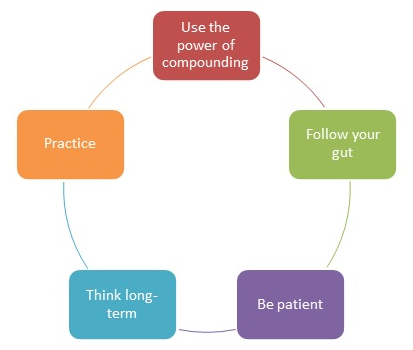Passive Investing
The passive Investing is a popular investment strategy worldwide. This strategy aims at getting maximum returns with minimum sales and purchase.
What is Passive Investing?
Passive investing strategy aims at keeping costs as low as possible, but building on returns. This strategy looks to avoid any fees or limited performance that occurs with trading frequently. It focuses on building on wealth gradually.

It emphasises on buying security for long-term and therefore it is also known as the buy-and-hold strategy. This means that it focusses on buying a good collection of long-term holdings that are balanced across various industries, sectors, Market capitalisation sizes and countries. These holdings are never sold under almost any circumstance despite the distress in conditions.
Passive investing works well under the majority of the circumstances because investors are protected from their own irrational behaviour. Investors are prone to panic or have little or no knowledge of Accounting and finance along with time constraints. The passive investing strategy helps investing at a low cost and gaining returns in the long-term.
Passive Investing and Index Funds
Passive investment strategy has received due attention only in the past few decades. Index Funds help in taking the full advantage of this strategy by helping with regular purchases along with other additional purchases through the dollar-cost averaging method.
Index funds were introduced in the 1970s. It made some successful returns in the market. In the 1990s, ETFs that tracks major indices like SPDR S&P 500 ETF (SPY), made this process simpler by letting investors trade index funds like stocks.
Talk to our investment specialist
Benefits of Passive Investing
Passive investing through indexing is a brilliant way of diversification. Maintaining a well-diversified Portfolio is essential for investors to successfully invest.
1. Low fees
As there is no fund management team to pick stocks, it comes at low cost. Passive stocks follow the index they employ as the benchmark.
2. Efficiency
Passive investing is a buy-and-hold strategy, which helps investors to assess and hold their stocks for the long-term. Therefore, the investor will not be seeing any massive Capital Gain within a year, which leads to tax-Efficiency.
3. Transparency
Its major advantage is when passive investing is done through index funds. It is because assets are clearly visible when it comes to index funds.
4. Ease of implementation
Since it involves index funds, a group of indices is easier to implement and also comprehend than a more dynamic strategy. Dynamic strategies involve constant research and adjustment.
Difference Between Passive Investing and Active Investing
Passive investing and active investment strategies have certain differences.
They are mentioned below:
| Passive Investing | Active Investing |
|---|---|
| Passive Investing involves low costs | Active investing is very expensive because of active buying, etc. |
| Passive investing is limited to a particular index or already determined set of investment with no scope for a variance | Active investing involves flexibility with the buying of stocks and don’t require to follow a specific index |
Types of Passive Investing Strategies
Passive investing is about portfolios tied with index funds or ETFs. However, take a look at the strategies mentioned below:
1. Index Fund
An investor can buy index funds to take complete advantage of this strategy. Index fund purchases the entire index stock with the same proportion as the index. This can be purchased from distributors and fund houses online. One of the major advantages of index funds is that the costs are extremely low as compared to active funds.
2. Exchange Trade Funds
Exchange Trade Funds (ETFs) create a portfolio of index stocks in the same proportion as the index fund. However, ETFs are listed on the stock exchange and can be purchased and sold at popular well-known stock exchanges. Investors can avail ETFs on gold, silver, equity indices, debt market indices, etc. This can be purchased and sold through the investor’s existing equity Trading Account and can be held under the regular Demat account.
3. Direct Equity
Investors can use the passive investing strategy with direct equities too. But the challenge will lie in the tracking index changes, weightage changes, corporate actions among others.
4 Major Tips of Passive Investing
If you are looking for investing with the passive investing strategy in mind, there are certain things you should be aware of. They are mentioned below:
1. Long-term plan
If you are looking forwards to invest in a long-term, then you should opt for this strategy. Otherwise, it is advisable to consider other options for investment.
2. Wanting to spend less
As an investor, if you are looking to spend less because of various reasons, a passive investment strategy can be considered.
3. Time constraints
As an investor, if you don’t wish to spend much time managing assets, then this strategy would be ideal for you.
4. Difficulty with interference
If you are looking for a strategy that will help you deal with not interfering with your investments, then you should opt for the passive investment strategy. It will help you keep yourself away from interfering with your investments in periods of panic or distress. This will help you deal with interference that is usually the problem with investing regularly.
Frequently checking portfolio will bring various emotions in play like over-enthusiasm or discouragement and panic. In such times, investors are bound to transfer funds. This goes against the core principle of passive investing.
Passive Investing a Boon in India
In India, the passive investing strategy in exchange-traded funds (ETFs) is gaining momentum. According to data from the Association of Mutual Funds in India (AMFI), ETFs attracted Rs. 24,083 crore in the first eight months of the financial year 2020. This was because of double inflow based on Large cap funds and half of the total inflows based on Equity Funds during the time. Therefore, the combined flow in equity scheme between April and November 2019 was Rs. 48,891 crore.
A report mentioned that the lower expense ratio, market polarisation for large-cap stocks, converging returns with large-cap funds, provident funds investment in an equity markets by ETFs play the major role in this increase.
Best Passive Investing Funds 2025 - 2026
Here are the best index Passive Funds you can choose to invest:
Fund NAV Net Assets (Cr) 3 MO (%) 6 MO (%) 1 YR (%) 3 YR (%) 5 YR (%) 2024 (%) Nippon India Index Fund - Sensex Plan Growth ₹43.3151
↓ -0.19 ₹989 4 2.1 9.9 13.1 12.7 9.8 LIC MF Index Fund Sensex Growth ₹158.858
↓ -0.71 ₹94 3.9 1.8 9.1 12.5 12.1 9.1 Franklin India Index Fund Nifty Plan Growth ₹211.316
↓ -0.58 ₹788 4.4 3.1 11.5 14.2 13.6 11.3 IDBI Nifty Index Fund Growth ₹36.2111
↓ -0.02 ₹208 9.1 11.9 16.2 20.3 11.7 Nippon India Index Fund - Nifty Plan Growth ₹44.451
↓ -0.12 ₹3,052 4.4 3.1 11.7 14.2 13.5 11.4 Note: Returns up to 1 year are on absolute basis & more than 1 year are on CAGR basis. as on 6 Jan 26 Research Highlights & Commentary of 5 Funds showcased
Commentary Nippon India Index Fund - Sensex Plan LIC MF Index Fund Sensex Franklin India Index Fund Nifty Plan IDBI Nifty Index Fund Nippon India Index Fund - Nifty Plan Point 1 Upper mid AUM (₹989 Cr). Bottom quartile AUM (₹94 Cr). Lower mid AUM (₹788 Cr). Bottom quartile AUM (₹208 Cr). Highest AUM (₹3,052 Cr). Point 2 Established history (15+ yrs). Established history (23+ yrs). Oldest track record among peers (25 yrs). Established history (15+ yrs). Established history (15+ yrs). Point 3 Top rated. Rating: 1★ (upper mid). Rating: 1★ (lower mid). Rating: 1★ (bottom quartile). Rating: 1★ (bottom quartile). Point 4 Risk profile: Moderately High. Risk profile: Moderately High. Risk profile: Moderately High. Risk profile: Moderately High. Risk profile: Moderately High. Point 5 5Y return: 12.69% (lower mid). 5Y return: 12.15% (bottom quartile). 5Y return: 13.61% (top quartile). 5Y return: 11.74% (bottom quartile). 5Y return: 13.54% (upper mid). Point 6 3Y return: 13.13% (bottom quartile). 3Y return: 12.53% (bottom quartile). 3Y return: 14.16% (lower mid). 3Y return: 20.28% (top quartile). 3Y return: 14.25% (upper mid). Point 7 1Y return: 9.86% (bottom quartile). 1Y return: 9.14% (bottom quartile). 1Y return: 11.48% (lower mid). 1Y return: 16.16% (top quartile). 1Y return: 11.70% (upper mid). Point 8 1M return: -0.81% (bottom quartile). 1M return: -0.86% (bottom quartile). 1M return: -0.09% (lower mid). 1M return: 3.68% (top quartile). 1M return: -0.07% (upper mid). Point 9 Alpha: -0.51 (upper mid). Alpha: -1.17 (bottom quartile). Alpha: -0.60 (lower mid). Alpha: -1.03 (bottom quartile). Alpha: -0.47 (top quartile). Point 10 Sharpe: 0.21 (bottom quartile). Sharpe: 0.16 (bottom quartile). Sharpe: 0.30 (lower mid). Sharpe: 1.04 (top quartile). Sharpe: 0.31 (upper mid). Nippon India Index Fund - Sensex Plan
LIC MF Index Fund Sensex
Franklin India Index Fund Nifty Plan
IDBI Nifty Index Fund
Nippon India Index Fund - Nifty Plan
*Below is the list for Index Mutual Funds having atleast 15 Crore or more in Net Assets.
The primary investment objective of the scheme is to replicate the composition of the Sensex, with a view to generate returns that are commensurate with the performance of the Sensex, subject to tracking errors. Below is the key information for Nippon India Index Fund - Sensex Plan Returns up to 1 year are on The main investment objective of the fund is to generate returns commensurate with the performance of the index either Nifty / Sensex based on the plans by investing in the respective index stocks subject to tracking errors. Research Highlights for LIC MF Index Fund Sensex Below is the key information for LIC MF Index Fund Sensex Returns up to 1 year are on The Investment Objective of the Scheme is to invest in companies whose securities are included in the Nifty and subject to tracking errors, endeavouring to attain results commensurate with the Nifty 50 under NSENifty Plan Research Highlights for Franklin India Index Fund Nifty Plan Below is the key information for Franklin India Index Fund Nifty Plan Returns up to 1 year are on The investment objective of the scheme is to invest in the stocks and equity related instruments comprising the S&P CNX Nifty Index in the same weights as these stocks represented in the Index with the intent to replicate the performance of the Total Returns Index of S&P CNX Nifty index. The scheme will adopt a passive investment strategy and will seek to achieve the investment objective by minimizing the tracking error between the S&P CNX Nifty index (Total Returns Index) and the scheme. Research Highlights for IDBI Nifty Index Fund Below is the key information for IDBI Nifty Index Fund Returns up to 1 year are on The primary investment objective of the scheme is to replicate the composition of the Nifty 50, with a view to generate returns that are commensurate with the
performance of the Nifty 50, subject to tracking errors. Research Highlights for Nippon India Index Fund - Nifty Plan Below is the key information for Nippon India Index Fund - Nifty Plan Returns up to 1 year are on 1. Nippon India Index Fund - Sensex Plan
Nippon India Index Fund - Sensex Plan
Growth Launch Date 28 Sep 10 NAV (06 Jan 26) ₹43.3151 ↓ -0.19 (-0.44 %) Net Assets (Cr) ₹989 on 30 Nov 25 Category Others - Index Fund AMC Nippon Life Asset Management Ltd. Rating ☆☆ Risk Moderately High Expense Ratio 0.49 Sharpe Ratio 0.21 Information Ratio -10.82 Alpha Ratio -0.51 Min Investment 5,000 Min SIP Investment 100 Exit Load 0-7 Days (0.25%),7 Days and above(NIL) Growth of 10,000 investment over the years.
Date Value 31 Dec 20 ₹10,000 31 Dec 21 ₹12,243 31 Dec 22 ₹12,861 31 Dec 23 ₹15,363 31 Dec 24 ₹16,723 31 Dec 25 ₹18,364 Returns for Nippon India Index Fund - Sensex Plan
absolute basis & more than 1 year are on CAGR (Compound Annual Growth Rate) basis. as on 6 Jan 26 Duration Returns 1 Month -0.8% 3 Month 4% 6 Month 2.1% 1 Year 9.9% 3 Year 13.1% 5 Year 12.7% 10 Year 15 Year Since launch 10.1% Historical performance (Yearly) on absolute basis
Year Returns 2024 9.8% 2023 8.9% 2022 19.5% 2021 5% 2020 22.4% 2019 16.6% 2018 14.2% 2017 6.2% 2016 27.9% 2015 2% Fund Manager information for Nippon India Index Fund - Sensex Plan
Name Since Tenure Himanshu Mange 23 Dec 23 1.94 Yr. Data below for Nippon India Index Fund - Sensex Plan as on 30 Nov 25
Asset Allocation
Asset Class Value Cash 0.07% Equity 99.93% Top Securities Holdings / Portfolio
Name Holding Value Quantity HDFC Bank Ltd (Financial Services)
Equity, Since 31 Oct 10 | 50018015% ₹150 Cr 1,487,642
↑ 27,539 Reliance Industries Ltd (Energy)
Equity, Since 31 Oct 10 | 50032511% ₹104 Cr 663,837
↑ 12,288 ICICI Bank Ltd (Financial Services)
Equity, Since 31 Oct 10 | 53217410% ₹97 Cr 700,493
↑ 12,967 Bharti Airtel Ltd (Communication Services)
Equity, Since 31 Oct 10 | 5324546% ₹56 Cr 268,529
↑ 4,971 Infosys Ltd (Technology)
Equity, Since 31 Oct 10 | 5002096% ₹55 Cr 350,524
↑ 6,488 Larsen & Toubro Ltd (Industrials)
Equity, Since 29 Feb 12 | 5005105% ₹47 Cr 114,709
↑ 2,123 State Bank of India (Financial Services)
Equity, Since 31 Oct 10 | 5001124% ₹40 Cr 407,528
↑ 7,544 ITC Ltd (Consumer Defensive)
Equity, Since 29 Feb 12 | 5008754% ₹38 Cr 946,228
↑ 17,516 Axis Bank Ltd (Financial Services)
Equity, Since 31 Dec 13 | 5322154% ₹36 Cr 280,021
↑ 5,183 Mahindra & Mahindra Ltd (Consumer Cyclical)
Equity, Since 31 Oct 10 | 5005203% ₹33 Cr 86,622
↑ 1,603 2. LIC MF Index Fund Sensex
LIC MF Index Fund Sensex
Growth Launch Date 14 Nov 02 NAV (06 Jan 26) ₹158.858 ↓ -0.71 (-0.44 %) Net Assets (Cr) ₹94 on 30 Nov 25 Category Others - Index Fund AMC LIC Mutual Fund Asset Mgmt Co Ltd Rating ☆ Risk Moderately High Expense Ratio 0.98 Sharpe Ratio 0.16 Information Ratio -9.92 Alpha Ratio -1.17 Min Investment 5,000 Min SIP Investment 1,000 Exit Load 0-1 Months (1%),1 Months and above(NIL) Growth of 10,000 investment over the years.
Date Value 31 Dec 20 ₹10,000 31 Dec 21 ₹12,189 31 Dec 22 ₹12,755 31 Dec 23 ₹15,183 31 Dec 24 ₹16,433 31 Dec 25 ₹17,930 Returns for LIC MF Index Fund Sensex
absolute basis & more than 1 year are on CAGR (Compound Annual Growth Rate) basis. as on 6 Jan 26 Duration Returns 1 Month -0.9% 3 Month 3.9% 6 Month 1.8% 1 Year 9.1% 3 Year 12.5% 5 Year 12.1% 10 Year 15 Year Since launch 13.2% Historical performance (Yearly) on absolute basis
Year Returns 2024 9.1% 2023 8.2% 2022 19% 2021 4.6% 2020 21.9% 2019 15.9% 2018 14.6% 2017 5.6% 2016 27.4% 2015 1.6% Fund Manager information for LIC MF Index Fund Sensex
Name Since Tenure Sumit Bhatnagar 3 Oct 23 2.16 Yr. Data below for LIC MF Index Fund Sensex as on 30 Nov 25
Asset Allocation
Asset Class Value Cash 0.15% Equity 99.85% Top Securities Holdings / Portfolio
Name Holding Value Quantity HDFC Bank Ltd (Financial Services)
Equity, Since 31 Mar 09 | 50018015% ₹14 Cr 142,029
↑ 1,606 Reliance Industries Ltd (Energy)
Equity, Since 31 Mar 09 | 50032511% ₹10 Cr 63,400
↑ 804 ICICI Bank Ltd (Financial Services)
Equity, Since 30 Apr 09 | 53217410% ₹9 Cr 66,836
↑ 785 Bharti Airtel Ltd (Communication Services)
Equity, Since 30 Apr 09 | 5324546% ₹5 Cr 25,638
↑ 282 Infosys Ltd (Technology)
Equity, Since 31 Mar 09 | 5002096% ₹5 Cr 33,495
↑ 474 Larsen & Toubro Ltd (Industrials)
Equity, Since 31 Mar 09 | 5005105% ₹4 Cr 10,931
↑ 136 State Bank of India (Financial Services)
Equity, Since 31 Mar 09 | 5001124% ₹4 Cr 38,915
↑ 531 ITC Ltd (Consumer Defensive)
Equity, Since 30 Sep 11 | 5008754% ₹4 Cr 90,256
↑ 1,389 Axis Bank Ltd (Financial Services)
Equity, Since 31 Dec 13 | 5322154% ₹3 Cr 26,802
↑ 465 Mahindra & Mahindra Ltd (Consumer Cyclical)
Equity, Since 31 Mar 12 | 5005203% ₹3 Cr 8,233
↑ 97 3. Franklin India Index Fund Nifty Plan
Franklin India Index Fund Nifty Plan
Growth Launch Date 4 Aug 00 NAV (06 Jan 26) ₹211.316 ↓ -0.58 (-0.27 %) Net Assets (Cr) ₹788 on 30 Nov 25 Category Others - Index Fund AMC Franklin Templeton Asst Mgmt(IND)Pvt Ltd Rating ☆ Risk Moderately High Expense Ratio 0.63 Sharpe Ratio 0.3 Information Ratio -3.88 Alpha Ratio -0.6 Min Investment 5,000 Min SIP Investment 500 Exit Load 0-30 Days (1%),30 Days and above(NIL) Growth of 10,000 investment over the years.
Date Value 31 Dec 20 ₹10,000 31 Dec 21 ₹12,429 31 Dec 22 ₹13,043 31 Dec 23 ₹15,684 31 Dec 24 ₹17,171 31 Dec 25 ₹19,106 Returns for Franklin India Index Fund Nifty Plan
absolute basis & more than 1 year are on CAGR (Compound Annual Growth Rate) basis. as on 6 Jan 26 Duration Returns 1 Month -0.1% 3 Month 4.4% 6 Month 3.1% 1 Year 11.5% 3 Year 14.2% 5 Year 13.6% 10 Year 15 Year Since launch 12.7% Historical performance (Yearly) on absolute basis
Year Returns 2024 11.3% 2023 9.5% 2022 20.2% 2021 4.9% 2020 24.3% 2019 14.7% 2018 12% 2017 3.2% 2016 28.3% 2015 3.3% Fund Manager information for Franklin India Index Fund Nifty Plan
Name Since Tenure Sandeep Manam 18 Oct 21 4.12 Yr. Shyam Sriram 26 Sep 24 1.18 Yr. Data below for Franklin India Index Fund Nifty Plan as on 30 Nov 25
Asset Allocation
Asset Class Value Cash 0.23% Equity 99.77% Top Securities Holdings / Portfolio
Name Holding Value Quantity HDFC Bank Ltd (Financial Services)
Equity, Since 31 Jan 03 | HDFCBANK13% ₹101 Cr 1,005,563
↑ 4,012 Reliance Industries Ltd (Energy)
Equity, Since 31 Jan 03 | RELIANCE9% ₹70 Cr 445,708
↑ 1,779 ICICI Bank Ltd (Financial Services)
Equity, Since 31 Jan 10 | ICICIBANK8% ₹65 Cr 469,827
↑ 1,875 Bharti Airtel Ltd (Communication Services)
Equity, Since 31 Mar 04 | BHARTIARTL5% ₹38 Cr 179,447
↑ 716 Infosys Ltd (Technology)
Equity, Since 29 Feb 12 | INFY5% ₹37 Cr 237,196
↑ 947 Larsen & Toubro Ltd (Industrials)
Equity, Since 30 Jun 12 | LT4% ₹31 Cr 77,319
↑ 308 State Bank of India (Financial Services)
Equity, Since 31 Jan 03 | SBIN3% ₹27 Cr 273,170
↑ 1,091 ITC Ltd (Consumer Defensive)
Equity, Since 31 Mar 11 | ITC3% ₹26 Cr 634,340
↑ 2,531 Axis Bank Ltd (Financial Services)
Equity, Since 30 Jun 09 | AXISBANK3% ₹24 Cr 188,548
↑ 753 Mahindra & Mahindra Ltd (Consumer Cyclical)
Equity, Since 28 Feb 07 | M&M3% ₹22 Cr 58,349
↑ 233 4. IDBI Nifty Index Fund
IDBI Nifty Index Fund
Growth Launch Date 25 Jun 10 NAV (28 Jul 23) ₹36.2111 ↓ -0.02 (-0.06 %) Net Assets (Cr) ₹208 on 30 Jun 23 Category Others - Index Fund AMC IDBI Asset Management Limited Rating ☆ Risk Moderately High Expense Ratio 0.9 Sharpe Ratio 1.04 Information Ratio -3.93 Alpha Ratio -1.03 Min Investment 5,000 Min SIP Investment 500 Exit Load NIL Growth of 10,000 investment over the years.
Date Value 31 Dec 20 ₹10,000 31 Dec 21 ₹12,349 31 Dec 22 ₹12,930 Returns for IDBI Nifty Index Fund
absolute basis & more than 1 year are on CAGR (Compound Annual Growth Rate) basis. as on 6 Jan 26 Duration Returns 1 Month 3.7% 3 Month 9.1% 6 Month 11.9% 1 Year 16.2% 3 Year 20.3% 5 Year 11.7% 10 Year 15 Year Since launch 10.3% Historical performance (Yearly) on absolute basis
Year Returns 2024 2023 2022 2021 2020 2019 2018 2017 2016 2015 Fund Manager information for IDBI Nifty Index Fund
Name Since Tenure Data below for IDBI Nifty Index Fund as on 30 Jun 23
Asset Allocation
Asset Class Value Top Securities Holdings / Portfolio
Name Holding Value Quantity 5. Nippon India Index Fund - Nifty Plan
Nippon India Index Fund - Nifty Plan
Growth Launch Date 28 Sep 10 NAV (06 Jan 26) ₹44.451 ↓ -0.12 (-0.27 %) Net Assets (Cr) ₹3,052 on 30 Nov 25 Category Others - Index Fund AMC Nippon Life Asset Management Ltd. Rating ☆ Risk Moderately High Expense Ratio 0.49 Sharpe Ratio 0.31 Information Ratio -12.08 Alpha Ratio -0.47 Min Investment 5,000 Min SIP Investment 100 Exit Load 0-7 Days (0.25%),7 Days and above(NIL) Growth of 10,000 investment over the years.
Date Value 31 Dec 20 ₹10,000 31 Dec 21 ₹12,402 31 Dec 22 ₹12,978 31 Dec 23 ₹15,642 31 Dec 24 ₹17,111 31 Dec 25 ₹19,053 Returns for Nippon India Index Fund - Nifty Plan
absolute basis & more than 1 year are on CAGR (Compound Annual Growth Rate) basis. as on 6 Jan 26 Duration Returns 1 Month -0.1% 3 Month 4.4% 6 Month 3.1% 1 Year 11.7% 3 Year 14.2% 5 Year 13.5% 10 Year 15 Year Since launch 10.3% Historical performance (Yearly) on absolute basis
Year Returns 2024 11.4% 2023 9.4% 2022 20.5% 2021 4.6% 2020 24% 2019 14.3% 2018 12.3% 2017 3.5% 2016 29% 2015 2.5% Fund Manager information for Nippon India Index Fund - Nifty Plan
Name Since Tenure Himanshu Mange 23 Dec 23 1.94 Yr. Data below for Nippon India Index Fund - Nifty Plan as on 30 Nov 25
Asset Allocation
Asset Class Value Cash 0.03% Equity 99.97% Top Securities Holdings / Portfolio
Name Holding Value Quantity HDFC Bank Ltd (Financial Services)
Equity, Since 31 Oct 10 | HDFCBANK13% ₹393 Cr 3,900,923
↑ 195,415 Reliance Industries Ltd (Energy)
Equity, Since 31 Oct 10 | RELIANCE9% ₹271 Cr 1,729,053
↑ 86,616 ICICI Bank Ltd (Financial Services)
Equity, Since 31 Oct 10 | ICICIBANK8% ₹253 Cr 1,822,620
↑ 91,304 Bharti Airtel Ltd (Communication Services)
Equity, Since 31 Oct 10 | BHARTIARTL5% ₹146 Cr 696,136
↑ 34,873 Infosys Ltd (Technology)
Equity, Since 31 Oct 10 | INFY5% ₹144 Cr 920,163
↑ 46,095 Larsen & Toubro Ltd (Industrials)
Equity, Since 29 Feb 12 | LT4% ₹122 Cr 299,949
↑ 15,026 State Bank of India (Financial Services)
Equity, Since 31 Oct 10 | SBIN3% ₹104 Cr 1,059,718
↑ 53,086 ITC Ltd (Consumer Defensive)
Equity, Since 29 Feb 12 | ITC3% ₹99 Cr 2,460,823
↑ 123,274 Axis Bank Ltd (Financial Services)
Equity, Since 31 Oct 10 | AXISBANK3% ₹94 Cr 731,441
↑ 36,642 Mahindra & Mahindra Ltd (Consumer Cyclical)
Equity, Since 31 Oct 10 | M&M3% ₹85 Cr 226,355
↑ 11,340
Conclusion
The passive investing strategy has yielded successful results so far. However, it is important that investors don’t predict future results based on historical data. It is important to understand various aspects of investing well and then commit to it.
All efforts have been made to ensure the information provided here is accurate. However, no guarantees are made regarding correctness of data. Please verify with scheme information document before making any investment.













Research Highlights for Nippon India Index Fund - Sensex Plan